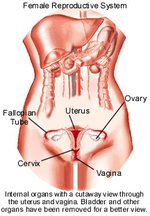Menstruation

Menstruation (a period) represents a major stage of puberty in girls; it's one of the many physical signs that a girl is turning into a woman. And like a lot of the other changes associated with puberty, menstruation can be confusing for girls (and guys). Some girls can't wait to start their periods, whereas others may feel afraid or anxious. Many girls and guys don't have a complete understanding of a woman's reproductive system or what actually happens during the menstrual cycle, making the process seem even more mysterious.
Puberty and PeriodsWhen girls begin to go through puberty (usually starting between the ages of 8 and 13), their bodies and minds change in many ways. The hormones in their bodies stimulate new physical development, such as growth and breast development. About 2 to 2 1/2 years after a girl's breasts begin to develop, she usually gets her first menstrual period.
About 6 months or so before getting her first period, a girl might notice an increased amount of clear vaginal discharge. This discharge is common. There's no need for a girl to worry about discharge unless it has a strong odor or causes itchiness.
The start of periods is known as menarche (pronounced: meh-nar-kee). Menarche doesn't happen until all the parts of a girl's reproductive system have matured and are working together.
Baby girls are born with ovaries, fallopian tubes, and a uterus. The two ovaries are oval-shaped and sit on either side of the uterus (womb) in the lowest part of the abdomen called the pelvis. They contain thousands of eggs, or ova. The two fallopian tubes are long and thin - like hollow strands of spaghetti (only a little bit thicker). Each fallopian tube stretches from an ovary to the uterus, a pear-shaped organ that sits in the middle of the pelvis. The muscles in a female's uterus are powerful and are able to expand to allow the uterus to accommodate a growing fetus and then help push the baby out during labor.
As a girl matures and enters puberty, the pituitary gland releases hormones that stimulate the ovaries to produce other hormones called estrogen and progesterone. These hormones have many effects on a girl's body, including physical maturation, growth, and emotions.
About once a month, a tiny egg leaves one of the ovaries - a process called ovulation - and travels down one of the fallopian tubes toward the uterus. In the days before ovulation, the hormone estrogen stimulates the uterus to build up its lining with extra blood and tissue, making the walls of the uterus thick and cushioned. This happens to prepare the uterus for pregnancy: If the egg reaches the uterus and is fertilized by a sperm cell, it attaches to the cushiony wall of the uterus, where it slowly develops into a baby.
If the egg isn't fertilized, though - which is the case during most of a girl's monthly cycles - it doesn't attach to the wall of the uterus. When this happens, the uterus sheds the extra tissue lining. The blood, tissue, and unfertilized egg leave the uterus, going through the vagina on the way out of the body. This is a menstrual period. This cycle happens almost every month for several more decades (except, of course, when a female is pregnant) until a woman reaches menopause and no longer releases eggs from her ovaries.



0 Comments:
Post a Comment
<< Home